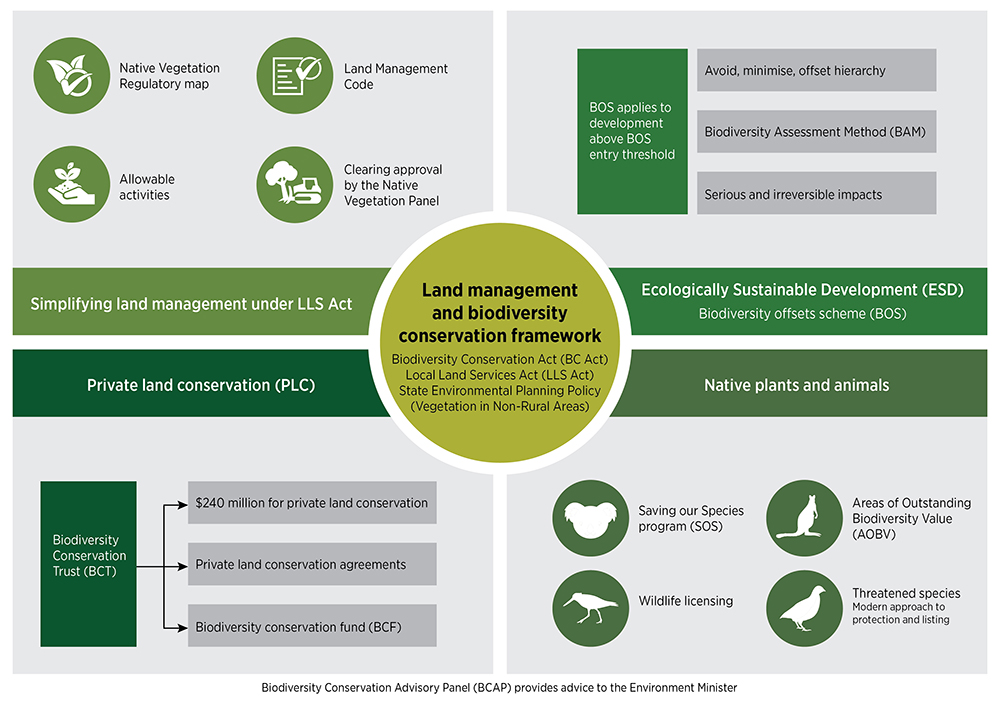The Biodiversity Conservation Act 2016 (NSW) commenced on 25 August 2017 as part of the land management biodiversity conservation reforms.
The reforms introduced some significant changes to:
- the way we protect our biodiversity
- how we regulate a range of development activities on land
- how the impacts of these activities on the natural environment are managed.
Parts of the Biodiversity Conservation Act
| Part | Title | Information |
|---|---|---|
| Part 1 | Preliminary | This part states the name, commencement date and purpose of the Biodiversity Conservation Act (BC Act). It details the application of the BC Act to terrestrial environment and what biodiversity and biodiversity values mean for the purposes of the BC Act. It also includes definitions of key terms used in the BC Act. |
| Part 2 | Protection of plants and animals | This part establishes the offences and limited defences under the BC Act. It also sets out the framework for biodiversity conservation licences that provide authorisation to undertake activities that would otherwise be an offence. This replaces the previous licensing regime under the Threatened Species Conservation Act 1995 and National Parks and Wildlife Act 1974. |
| Part 3 | Areas of outstanding biodiversity value | This part establishes a new instrument for the conservation of areas that meet established criteria. This replaces critical habitats under the Threatened Species Conservation Act 1995 and deems the existing critical habitats to be areas of outstanding biodiversity value. |
| Part 4 | Threatened species and threatened ecological communities | This part sets out a new process for listing threatened plants and animals and aligns with standards developed by the International Union for Conservation of Nature (IUCN). It establishes the biodiversity conservation program (known as Saving our Species) for threatened species and threatened ecological communities. It establishes the Scientific Committee and sets out its functions. |
| Part 5 | Investment strategy and private land conservation agreements | This part establishes the private land conservation framework, and the requirements to develop a Biodiversity Conservation Investment and a biodiversity values map. This part establishes the 3 types of private land conservation agreements and prescribes content, duration and variation and other provisions. |
| Part 6 | Biodiversity offsets scheme | This part establishes the biodiversity offsets scheme, including provisions for establishing a method to assess biodiversity, the creation of, and dealings with, biodiversity credits, scheme for accreditation and the Biodiversity Conservation Fund. |
| Part 7 | Biodiversity assessment and approvals under Planning Act | This part sets out biodiversity assessment requirements for different activities, including state significant development or infrastructure and when a Minister’s concurrence is required. |
| Part 8 | Biodiversity certification of land | This part establishes the framework for biodiversity certification. |
| Part 9 | Public consultation and public registers | This part sets out uniform requirements for consultation and the publication of registers under the BC Act. |
| Part 10 | Biodiversity Conservation Trust | This part establishes the body Biodiversity Conservation Trust and sets out the Trust’s functions. |
| Part 11 | Regulatory compliance mechanisms | This part sets out the range of compliance mechanisms, including stop work orders, interim protection orders, remediation orders, biodiversity offsets enforcement orders and directions relating to protected animals and threatened species of animals. |
| Part 12 | Investigation powers | This part sets out the investigative powers, including authorised officers, powers to require information and records, and powers under the BC Act. |
| Part 13 | Criminal and civil proceedings | This part sets out liabilities for offences and types of proceedings that may be taken and orders that may be made. |
| Part 14 | Miscellaneous | This part includes provisions for the establishment of a Biodiversity Conservation Advisory Panel, biodiversity information programs, delegations of functions and the relationship of the BC Act to other Acts. |
| Schedules | Schedules | Schedule 1 – Threatened species Schedule 2 – Threatened ecological communities Schedule 3 – Extinct species, species extinct in the wild and collapsed ecological communities Schedule 4 – Key threatening processes Schedule 5 – Protected animals Schedule 6 – Protected plants Schedule 7 – Provisions relating to members and procedure of Threatened Species Scientific Committee Schedule 8 – Members and procedures of Board of Biodiversity Conservation Trust Schedule 9 – Savings, transitional and other provisions |
How we manage land and conservation activities
Key reform areas
Legislative framework
New legislation introduces a balanced approach to land management and biodiversity conservation in New South Wales.
Key elements of the land management and biodiversity conservation framework are a new Biodiversity Conservation Act 2016 (BC Act), amendments to the Local Land Services Act 2013 (LLS Act), and associated regulations.
The purpose of the BC Act is to maintain a healthy, productive and resilient environment for the greatest well-being of the community, now and into the future, consistent with the principles of ecologically sustainable development.
The State Environmental Planning Policy (Vegetation in Non-Rural Areas) 2017 aims to preserve urban amenity through preservation of urban vegetation and to protect biodiversity values of urban vegetation.
Simplifying land management
Landholders have more choices to manage native vegetation on their property to improve agricultural productivity and biodiversity outcomes.
The Local Land Services Act regulates rural native vegetation and land management. The Native Vegetation Regulatory map designates rural land into:
- category 1 – exempt land, where clearing can be carried out without an approval or notification processes
- category 2 – regulated land, where landholders may need an approval to clear.
Find more information about the land management framework.
Ecologically sustainable development
The biodiversity conservation legislation establishes a framework for assessing and offsetting biodiversity impacts from proposed development:
- A biodiversity offsets scheme delivers a transparent, consistent and scientifically based approach to biodiversity assessment and offsetting. It implements an avoid, minimise and offset framework, and recognises there are some types of impacts that are not acceptable.
- A biodiversity assessment method delivers a single, clear and scientifically robust approach to assess biodiversity impacts from development and applies to development that is likely to significantly affect threatened species or ecological communities.
The concept of serious and irreversible impacts is fundamentally about protecting threatened entities that are most at risk of extinction from potential development.
Biodiversity Offsets Scheme Help Desk and support
Need help? Contact the BOS Help Desk for assistance or to give feedback or ask a question about the Biodiversity Offsets Scheme.
Private land conservation
More than 80% of land in New South Wales is privately managed. Government investment helps landholders to protect and conserve high-value biodiversity on private land.
The Biodiversity Conservation Trust (BCT) supports and encourages landholders to protect and conserve biodiversity on private land. The Trust is guided by the biodiversity conservation investment strategy.
There are 3 types of private land conservation agreements: biodiversity stewardship agreements, conservation agreements and wildlife refuge agreements.
Development proponents may choose to pay into the Biodiversity Conservation Fund as an alternative to retiring biodiversity credits.
Native animals and plants
Legal protection of threatened species and protected native animals and plants in New South Wales are strengthened and modernised.
Saving our Species is the government’s strategic management framework, outlining management actions to secure NSW’s threatened plants and animals in the wild for the next 100 years. As part of the land management and biodiversity conservation reforms, the government committed a further $100 million over 5 years from 2016–17.
The BC Act establishes a new instrument for the conservation of areas that meet established criteria for an area of outstanding biodiversity value.
The reforms introduce a risk-based approach to wildlife licensing. This means that:
- low-risk activities will be exempt from regulation
- moderate-risk activities will be regulated by enforceable codes of practice
- high-risk activities will continue to be licensed.
There are offences for harming and picking threatened species, ecological communities and protected plants and animals. Strong deterrents are in place for illegally dealing in and possessing protected animals and protected native plants.
Approaches to listing and conserving threatened species and ecological communities have been modernised, including eligibility criteria for determining a species' or community’s risk of extinction.
The BC Act establishes a new Biodiversity Conservation Advisory Panel to provide expert advice.
Background to the reforms
The current system is the product of extensive independent review and stakeholder and community engagement and input. The reforms modernise the state’s land clearing and conservation laws.

